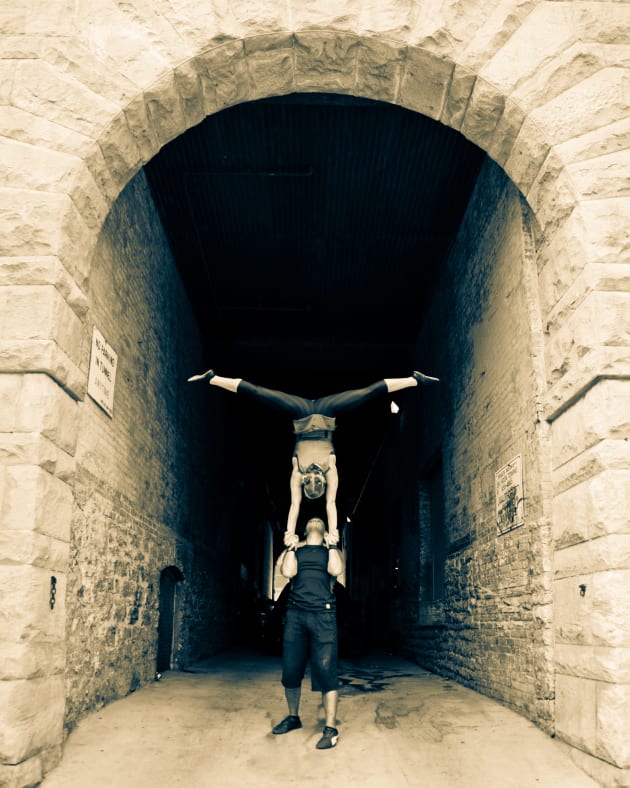Joining the circus
Like dance, professional level circus training is multi-faceted, involving both technical and artistic skill development, writes Allison K Williams.
FOR generations, circus skills were handed down through families. Training schools were accessible to an elite few, often
chosen by their communist governments as promising toddlers.
Now, recreational circus classes are offered at gyms and studios around the world, and flips and walkovers are moving into dance choreography. With the rise of contemporary circus companies like Australia’s Circa and Canada’s Seven Fingers of the Hand, a performance career is an option for young athletes, actors and dancers even without a previous circus connection. To fill the need
for young talent, circus training schools have opened around the world.
Just as tertiary dance training involves a mix of technical, artistic, creative and academic classes, the same is true of pre-professional circus courses. At the New England Center for Circus Arts (NECCA) in Vermont, USA, for example, first-year
students take five skills classes a week, conditioning classes, and study circus culture and history. The three-year Bachelor of Circus Arts at Australia’s National Institute of Circus Arts combines intensive technical training in a range of circus skills
with classes in contemporary dance technique, ballet, improvisation and composition. Then there are academic subjects such as history and culture of circus, anatomy, nutrition and business education, as well as classes in technical aspects of circus production.

Like dancers, circus students train to a high technical and artistic level, preparing for (hopefully!) a lifetime of performance. Before graduation, students work with specialist coaches to develop at least one bookable act; they also build employment connections through internships. Graduates join traditional or modern circus companies, cruise ships, cabarets, or run a small business booking and promoting themselves for shows and events. They must also maintain a demanding training schedule without a school around them - sometimes without even a studio.
Hula-hoop artist Lisa Lottie performs around the world and trains six days a week - often in hotel rooms. “If I don't train, I don’t get better and if I don’t get better, I get bored. My training is as important for stimulating creativity as it is for conditioning my skills and physicality,” she remarks. Lisa also spends a month each year teacher in Mysore, India.
While jaw-dropping technical skill is, obviously, a crucial part of an acrobatic or aerial act, it's certainly not the sole factor in creating a successful career. Modern circus training graduates students at a much higher level of skill and flexibility than even twenty years ago, and it’s no longer “big tricks” that distinguish one performer from another. In act development classes, schools stress theme and artistic intention to connect emotionally with the audience. While training, students can give compelling performances without risking their safety on showy moves they haven’t yet mastered. Once a professional level of skill is attained, performers find creativity and expression vital to their work.

Government circus schools in China and former Soviet countries still graduate hundreds of teenage circus performers with incredible skill. “There are twelve-year-old Mongolian girls doing triple-fold backbends I’ll never touch in my lifetime,” says aerialist/contortionist and NECCA graduate Marina Petrano. “Where I shine is choreography. It’s not about doing the craziest skill—it’s about beautiful, inventive presentation. Even up against my classmates, we can all do the splits. We can all do a triple roll-down in an aerial fabric. So our acts are about interesting transitions, what’s happening between the tricks, and how those movements express emotion and theme.”
Circus schools around the world agree, turning out strong soloists who can also participate as multi-skilled ensemble members in a theatrical circus show. “What we do as performers is what every dancer does,” says NECCA student Maggie King. “I want to take moments of incredible physical power and invest them with emotional content that moves the audience as much or more than it impresses them.”
Allison K Williams is a US-based writer and circus coach. She recently retired from performing full-time as an aerialist and acrobat, and served as artistic director of Aerial Angels (US), a contemporary circus company performing at festivals and events. She is head coach of Starfish Circus, the company's school residency program.



